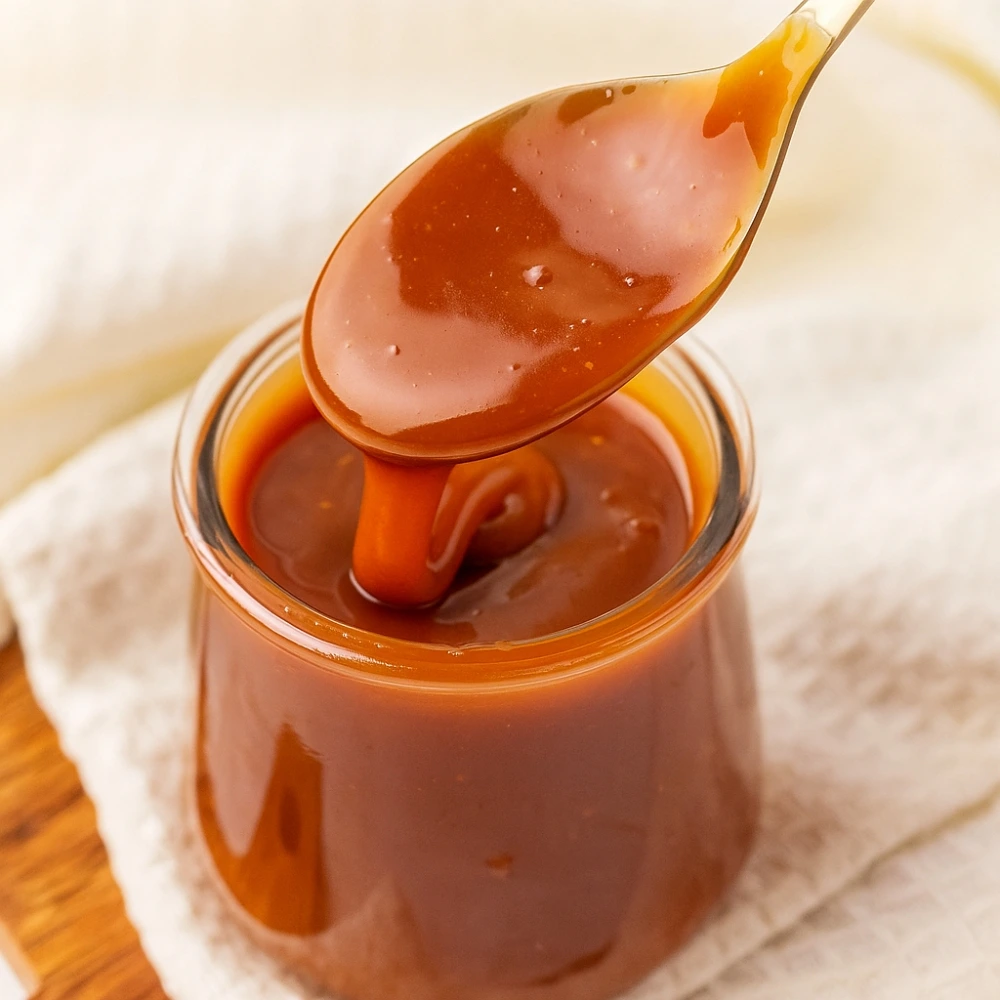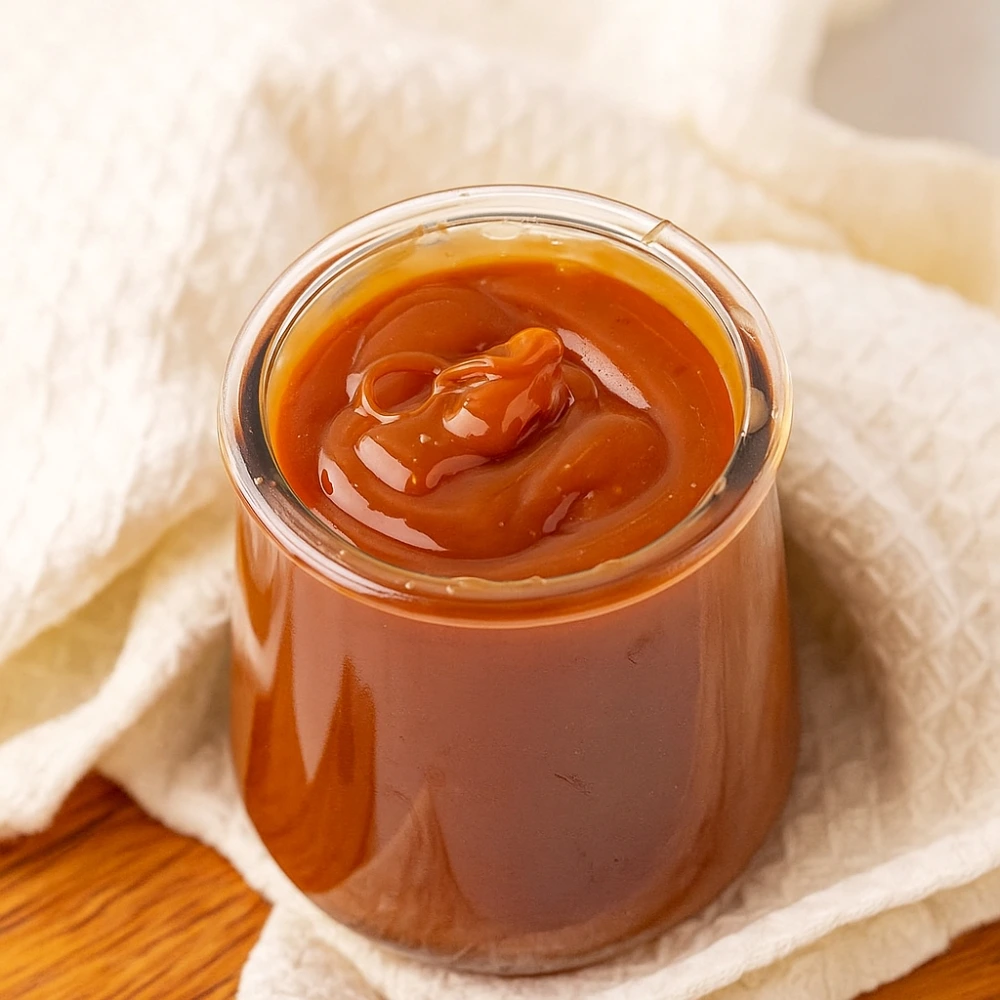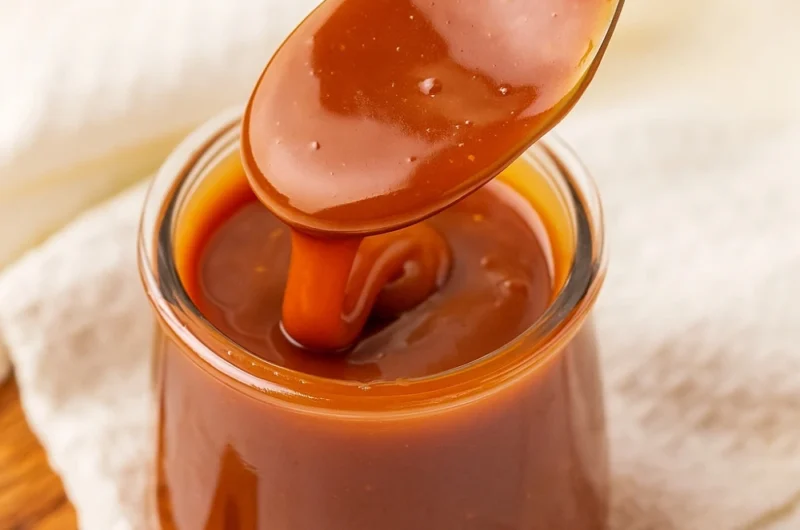The Best Fluffy Pancakes recipe you will fall in love with. Full of tips and tricks to help you make the best pancakes.
Homemade Caramel Sauce Guide (Science-Backed & Customizable)

Let’s be honest—making homemade caramel sauce can feel intimidating. One moment you’re watching sugar bubble away, the next you’re staring at a grainy, burnt mess wondering where it all went wrong. But here’s the truth: caramel-making isn’t mysterious witchcraft. With the right caramel sauce recipe, scientific understanding, and proper techniques, anyone can master this luxurious confection.
This guide will transform you from caramel-anxious to caramel-confident. Whether you’re searching for an easy caramel sauce for beginners or advanced techniques for the perfect salted caramel sauce recipe, you’ll find everything you need right here. We’ll explore the science behind caramelization, provide foolproof step-by-step instructions, troubleshoot every possible disaster, and share creative variations that’ll make your taste buds sing.
Why THIS Caramel Sauce Recipe Works
What makes this guide different from the countless caramel recipes scattered across the internet? Let me break it down:
Simplicity Meets Reliability: This recipe uses just five core ingredients you probably already have. No exotic additions, no complicated techniques—just pure, scientific precision that delivers consistent results every single time.
Perfect Texture & Flavor: Imagine drizzling velvety, golden-brown caramel that’s neither too thick nor runny, with a rich buttery sweetness balanced by just a hint of salt. That’s exactly what you’ll achieve here.
Science-Backed Success: Every instruction in this guide has a “why” behind it. Understanding the chemistry of sugar crystallization and emulsification means you’re not just following directions—you’re becoming a caramel expert.
Unrivaled Troubleshooting: Grainy texture? Burnt flavor? Separated sauce? We’ve got solutions for every mishap, many of which can salvage your batch without starting over.
Endless Customization: From bourbon-spiked variations to vegan caramel sauce alternatives, this guide covers adaptations for every dietary preference and flavor craving.
As someone who’s spent years perfecting homemade confections and studying the science of baking, I’m passionate about demystifying techniques that seem complicated but are actually quite achievable with proper guidance.
Essential Ingredients for Perfect Caramel Sauce
The beauty of how to make caramel sauce lies in its simplicity. Here’s what you need and why each ingredient matters:
| Ingredient | Amount (Standard Recipe) | Purpose | Pro Tips |
|---|---|---|---|
| Granulated Sugar | 1 cup (200g) | Provides the base through caramelization | White sugar caramelizes most predictably; brown sugar adds molasses notes |
| Water | ¼ cup (60ml) | Dissolves sugar evenly, controls crystallization | Some recipes skip this, but water ensures even melting |
| Heavy Cream | ½ cup (120ml) | Stops cooking process, adds richness and body | Must be at least 36% fat; light cream will separate |
| Unsalted Butter | 3 tablespoons (42g) | Contributes silky mouthfeel and depth | European-style butter (higher fat) creates extra-luxurious texture |
| Salt | ½-1 teaspoon | Enhances sweetness, adds complexity | Flaky sea salt for salted caramel, fine salt for subtle enhancement |
The Science Behind Each Ingredient
Sugar undergoes caramelization—a complex chemical transformation where sucrose molecules break down and recombine, creating hundreds of new flavor compounds and that characteristic amber hue.
Water acts as a medium, helping sugar dissolve uniformly before evaporation allows temperature to rise sufficiently for caramelization. This “wet method” prevents hot spots that cause burning.
Heavy cream and butter serve dual purposes: their liquid content immediately lowers temperature (stopping the cooking process), while their fat creates a stable emulsion that gives caramel its signature smooth, pourable consistency.
Salt isn’t just for salted caramel sauce recipe variations—even a pinch amplifies sweetness perception and balances the intense sugar flavor, preventing cloying sweetness.
Smart Substitutions
Preventing Crystallization: Add 1-2 tablespoons corn syrup or glucose syrup to your sugar mixture. These “interfering agents” disrupt crystal formation, providing insurance against graininess.
Vegan Alternatives: Replace heavy cream with full-fat coconut cream (refrigerated overnight, use only the thick top layer) and swap butter for high-quality vegan butter. Expect slightly different consistency but excellent flavor.
Cream Alternatives: Half-and-half can work in a pinch, though the sauce will be thinner. Regular milk lacks sufficient fat and will likely separate—not recommended.
Equipment You’ll Need (and Why it Matters)
Having the right tools transforms caramel-making from stressful to straightforward:
Heavy-Bottomed Saucepan (2-3 quarts): Distributes heat evenly, preventing scorching. Light, thin pans create hot spots that burn sugar before proper caramelization occurs.
Candy Thermometer: Precision matters enormously. The difference between perfect amber (350°F) and burnt (375°F+) is mere minutes. Digital instant-read thermometers with clip attachments are ideal.
Heat-Proof Silicone Spatula or Whisk: Metal conducts heat dangerously; silicone withstands high temperatures safely. You’ll need this for stirring in cream and butter.
Pastry Brush: Essential for the “sugar washing” technique that prevents crystallization by brushing down sugar crystals from pan sides.
Liquid and Dry Measuring Cups: Accuracy ensures proper ratios. Better yet, use a kitchen scale for true precision—200g sugar every time.
Safety Equipment: Long oven mitts protect against splattering. Molten sugar reaches temperatures above 300°F—serious burn territory.
Step-by-Step: How to Make Foolproof Homemade Caramel Sauce
Let’s walk through each stage with the detail you need for guaranteed success:
1. Prep Your Ingredients (Mise en Place)
Measure everything before you start. Caramel waits for no one—once it reaches temperature, you need to act immediately. Bring heavy cream and butter to room temperature; this prevents temperature shock that causes separation.
2. Combine Sugar & Water
Add granulated sugar and water to your heavy-bottomed saucepan. Gently stir with a spatula just until the sugar looks like wet sand—completely moistened but not dissolved. The mixture should resemble wet beach sand before a wave hits.
3. The Boil & Caramelization Process
Temperature progression: Place pan over medium-high heat without stirring. The mixture will bubble vigorously as water evaporates (212°F/100°C). Once water evaporates completely, temperature rises rapidly.
Visual cues you’ll see:
- Minutes 0-5: Clear, bubbling liquid
- Minutes 5-8: Begins to thicken, large bubbles slow
- Minutes 8-10: Faint yellow tinge appears
- Minutes 10-12: Deepens to golden honey color
- Minutes 12-14: Rich amber (THIS IS YOUR WINDOW)
The Critical “Sugar Washing” Technique: Keep a pastry brush and small bowl of water nearby. If you see sugar crystals forming on pan sides above the liquid line, dip your brush in water and brush them down into the mixture. This single technique prevents 90% of crystallization problems.
What NOT to do: Resist stirring once the mixture boils. Agitation encourages crystal formation. Swirl the pan gently if needed to distribute heat, but keep that spatula out.
4. Achieving Perfect Amber
Watch for a deep amber color—think of dark honey or old copper pennies. Your thermometer should read 340-350°F (171-177°C). Remove from heat immediately. Caramel continues cooking from residual heat, so better slightly early than late.
5. Adding Butter
Drop in room-temperature butter. Safety warning: The mixture will bubble vigorously as moisture hits the hot sugar. Stir gently with your heat-proof spatula until butter fully incorporates, about 30 seconds.
6. Pouring in Cream
CRITICAL SAFETY ALERT: This step produces dramatic bubbling and steam. The sauce can triple in volume temporarily. Pour slowly, whisking constantly, keeping your face and hands back from the pan.
Add cream in a slow, steady stream while whisking continuously. The mixture will erupt into violent bubbling—this is normal. Keep whisking until the chaos subsides and you have a smooth, unified sauce.
7. Boiling Down to Desired Thickness
Return pan to medium heat and let the sauce bubble for 1-2 minutes. It will seem thin—that’s expected. Remember: caramel thickens considerably as it cools. For pourable sauce, aim for a consistency slightly thinner than honey while hot (around 225-230°F).
8. Adding Salt & Vanilla (Optional)
Stir in salt (start with ½ teaspoon for subtle enhancement, up to 1 teaspoon for pronounced salted caramel sauce recipe) and 1 teaspoon pure vanilla extract if desired. Mix thoroughly.
9. Cooling & Storing
Transfer to a heat-proof jar or bowl. Let cool to room temperature—it will thicken substantially. When completely cool, it should coat the back of a spoon but still flow slowly.

Troubleshooting Caramel Sauce: Fix Any Mistake!
Even experienced bakers encounter caramel challenges. Here’s your comprehensive problem-solving guide:
Problem: Grainy or Crystallized Caramel
Why it happens: Undissolved sugar crystals or agitation during cooking triggers chain-reaction crystallization.
Prevention strategies:
- Ensure sugar fully moistens before heating
- Use the pastry brush water technique religiously
- Don’t stir once mixture boils
- Consider adding 1 tablespoon corn syrup as crystal inhibitor
How to fix: If caught early, add ¼ cup water and reheat, stirring constantly until crystals dissolve. If extensively crystallized, starting over saves time and frustration.
Problem: Burnt, Bitter Taste
Why it happens: Sugar cooked beyond 375°F breaks down into acrid compounds.
Prevention: Use a thermometer, watch color carefully, and remove from heat at deep amber—not dark brown or black.
How to fix: Unfortunately, burnt flavor permeates completely and cannot be rescued. The only solution is starting fresh. Consider this tuition in the university of caramel-making.
Problem: Sauce Too Thin
Why it happens: Removed from heat too early, before sufficient water evaporated.
How to fix: Return to saucepan over medium heat and cook 1-2 minutes longer, stirring occasionally. Check consistency when cool—hot caramel always looks thinner than final result.
Problem: Sauce Too Thick or Hard
Why it happens: Overcooked past ideal temperature range.
How to fix: Gently reheat sauce with 2-3 tablespoons heavy cream or hot water, whisking until desired consistency returns. Add liquid gradually—you can always add more but can’t remove excess.
Problem: Separated or Curdled Appearance
Why it happens: Temperature shock from cold cream/butter, or fat separation from overheating during rewarming.
Prevention: Room temperature ingredients are non-negotiable. Add cream slowly while whisking.
How to fix: Reheat gently to 180°F while whisking vigorously. The emulsion often restabilizes with heat and agitation. If stubborn, add 1 tablespoon warm cream while whisking.
Problem: Caramel Didn’t Brown
Why it happens: Heat too low or insufficient cooking time.
How to fix: Simply continue cooking until you reach proper amber color. Patience is key—rushing with higher heat risks burning.
Delicious Caramel Sauce Variations & Customizations
Once you’ve mastered the basic best caramel sauce, a world of flavors awaits:
Classic Salted Caramel: Use flaky Maldon or fleur de sel, adding ¾-1 teaspoon at the end. The delicate crystals provide textural interest and flavor bursts.
Spiced Caramel: Add ½ teaspoon cinnamon, ¼ teaspoon nutmeg, or 3-4 crushed cardamom pods to cream before heating. Strain out whole spices before adding to caramel.
Boozy Caramel: Stir in 2-3 tablespoons bourbon, dark rum, Kahlúa, or Grand Marnier after removing from heat. Alcohol adds complexity without overwhelming sweetness.
Peanut Butter Caramel: Whisk in ⅓ cup creamy peanut butter while sauce is still hot. This creates an irresistible combination perfect for caramel sauce for apples or ice cream.
Brown Sugar Caramel: Replace half the granulated sugar with packed dark brown sugar. The molasses creates deeper, more complex flavor with toffee notes.
Chocolate Caramel: Stir 2 ounces chopped dark chocolate into finished hot sauce until melted and smooth.
Vegan Caramel Sauce: Use 1 cup granulated sugar, ¼ cup water, ½ cup full-fat coconut cream, 3 tablespoons vegan butter, and ½ teaspoon vanilla. Follow the same method, noting that coconut cream may require slightly longer cooking for proper thickness.
How to Store Homemade Caramel Sauce (and Reheat)
Proper storage maintains quality and safety:
Refrigeration: Store in an airtight container for 2-3 weeks. The high sugar content acts as preservative, but dairy components require refrigeration.
Freezing: Pour into freezer-safe containers or ice cube trays for portioned servings. Freeze up to 3 months. Thaw overnight in refrigerator.
Room Temperature: Not recommended due to dairy content and risk of bacterial growth.
Reheating: Microwave in 15-second intervals, stirring between, or warm gently in saucepan over low heat. If thickened excessively, whisk in splash of warm cream or milk to restore pourable consistency.
Creative Ways to Use Your Homemade Caramel Sauce
The versatility of easy caramel sauce extends far beyond simple drizzling:
Dessert Applications:
- Classic topping for vanilla ice cream, brownies, or cheesecake
- Filling between cake layers
- Swirled into bread pudding before baking
- Drizzled over pancakes, waffles, or French toast
- Dipping sauce for apple slices, pretzels, or churros
Baking Ingredient:
- Filled into cupcakes or doughnuts
- Layered in parfaits with whipped cream and fruit
- Incorporated into buttercream frosting
- Used as cookie filling
Beverage Enhancement:
- Stirred into coffee for homemade caramel macchiato
- Blended into milkshakes or smoothies
- Drizzled around the inside of glass for presentation
Gift-Giving: Package in attractive jars with fabric toppers and recipe cards. Homemade caramel makes thoughtful, delicious gifts for any occasion.
Unexpected Uses: Try as a glaze for roasted pork or chicken—the sweet-savory combination is restaurant-worthy.
Caramel Sauce FAQs
How long does it take to make caramel sauce? Active cooking time is 15-20 minutes, with most of that being hands-off watching. Total time including prep and cooling is about 45 minutes.
Do I need a candy thermometer for caramel sauce? While experienced bakers can judge by color and consistency, a thermometer provides precision that virtually guarantees success, especially for beginners. It’s a worthwhile $10-15 investment.
What’s the best pot for making caramel? A 2-3 quart heavy-bottomed stainless steel or enameled cast iron saucepan with light-colored interior (so you can monitor color changes) works best.
Why is my caramel sauce hard and rocky? This indicates crystallization from sugar crystals or overcooked caramel. Use the sugar washing technique and proper temperatures to prevent this.
Can I use milk instead of heavy cream? It’s not recommended. Milk’s lower fat content (3-4% versus cream’s 36%+) leads to separation and won’t create proper emulsion. The result will be thin and potentially grainy.
How do I clean a sticky caramel pot? Fill with hot water and simmer 5-10 minutes. The sugar dissolves completely, leaving an easily washable pan. This same principle works for utensils.
Is homemade caramel sauce safe for gifts? Absolutely, when properly made and stored. Provide refrigeration instructions and “use by” dates (2 weeks refrigerated). For room-temperature stability, you’d need to make caramel sauce without corn syrup using professional preservatives—the homemade version requires refrigeration.
Master Your Caramel, Transform Your Desserts
You now possess everything needed to create flawless homemade caramel sauce every single time. From understanding the precise science of caramelization to troubleshooting inevitable mishaps, you’re equipped with professional-level knowledge typically reserved for culinary schools.
The journey from intimidated to confident happens one batch at a time. Start with the classic recipe, experiment with variations as your comfort grows, and soon you’ll be the person friends ask for caramel-making advice.
Ready to transform ordinary desserts into extraordinary experiences? Grab your saucepan, measure your sugar, and let’s make some magic happen. Your perfect caramel sauce awaits—and trust me, once you taste the silky, buttery perfection you’ve created yourself, store-bought will never satisfy again.
Homemade Caramel Sauce Guide (Science-Backed & Customizable)
Course: Appetizers, DessertsCuisine: French6-8
servings15
minutes10
minutes120
kcalIngredients
1 cup granulated sugar
6 tbsp unsalted butter, cut into cubes
1/2 cup heavy cream, warmed
1/2 tsp vanilla extract (optional)
Pinch of salt (optional, for salted caramel)
Directions
- Melt the sugar: In a medium saucepan over medium heat, add the sugar. Stir continuously with a heat-resistant spatula or wooden spoon until it melts into a golden-brown liquid.
- Add the butter: Carefully add the butter (it will bubble vigorously). Stir until fully melted and combined.
- Add cream: Slowly pour in the warm heavy cream while stirring. The mixture will bubble and rise, then settle into a smooth sauce.
- Flavor & finish: Remove from heat, stir in vanilla extract and a pinch of salt if desired.
- Cool & store: Let cool slightly before using. Store in a glass jar in the fridge for up to 2 weeks. Reheat gently before serving.

